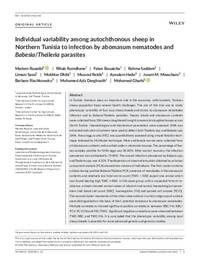Individual variability among autochthonous sheep in Northern Tunisia to infection by abomasum nematodes and Babesia/Theileria parasites

Authors:
In Tunisia, livestock plays an important role in the economy; unfortunately, Tunisian sheep population faces several health challenges. The aim of this trial was to study phenotypic variability of four local sheep breeds and strains to abomasum nematodes infection and toBabesia/Theileriaparasites. Faeces, blood and abomasum contents were collected from 310 sheep slaughtered in eight commercial slaughterhouses across North Tunisia. Haematological and biochemical parameters were assessed. DNA was extracted and catch-all primers were used to detect bothTheileriaspp. andBabesiaspp. DNA. Faecal egg counts (FEC) was quantitatively assessed using simple flotation technique followed by McMaster technique. Male and female worms were collected from all abomasum contents and counted under a stereomicroscope. The percentage of faeces samples positive for GIN's eggs was 30.82%. After worms' recovery, the infection prevalence was estimated to 75.90%. The overall infection prevalence byBabesiaspp. andTheileriaspp. was 4.21%. The dispersion of observations plots obtained by principal component analysis (PCA) showed two clusters of individuals. The first cluster contains animals having positiveBabesia/TheileriaPCR, presence of nematodes in the abomasum contents and relatively low total worm count (TWC < 500) expect one animal which was found bearing high TWC (>500). In this same group, with a suspected form of resistance, animals showed normal values of albumin and normal haematological parameters (red blood cell count [RBC], haemoglobin [Hb] and packed cell volume [PCV]). The second cluster represents all the other observations in which subgroups of animals were distinguished on the basis of their potential resistance to abomasum nematodes. Multiple correlations showed significant positive correlations between RBC/Hb, RBC/PCV, PCV/Hb and FEC/TWC. Significant negative correlations were observed between TWC/RBC and TWC/Hb. It is concluded that the phenotypic variability among local sheep breeds is essential for more advanced genetic and genomic studies.
